2014 Joint Mathematics Meetings
Elizabeth` Whiteley
Artists
Statement
I am fascinated with ways to create 2-D ornamental patterns such that the generator is not immediately obvious. My research into 19th Century British design led to the work of Lewis F. Day (1845-1910), who described a method for disguising the generator. I use his design method to create hand-drawn contemporary designs. After scanning the designs, I manipulate them digitally before printing. I find that a plane tiling design with a 2-D generator used as a P1 translation can yield interesting visual results if the generator is disguised.
Artworks

Plane Tiling: Rhombus 2
16"x20"
Digital print on Epson Velvet fine art paper
2013
I turn to Nature for inspiration for my artworks. In this 2-D ornamental pattern the generator contains hand drawn leaves presented on a rhombic plan with a half slip (or, drop repeat). The design intrigues the eye because the generator is not readily apparent. I include a background layer of vertical lines with broken spaces to serve as a clue to the geometric plan.

Plane Tiling: Square 1
16"x20"
Digital print on Epson Velvet fine art paper
2013
I look at Nature for inspiration for my artworks. In this 2-D ornamental pattern the generator contains hand drawn leaves presented on a square plan with a half slip (or, drop repeat). The design intrigues the eye because the unit cell is not readily apparent. I include a background layer of vertical lines with broken spaces to serve as a clue to the geometric plan.